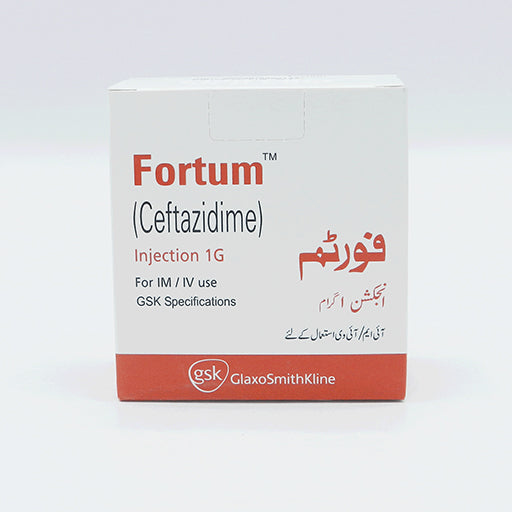Your cart is currently empty.
Fortum 1 g Injection (Ceftazidime) – 1 Vial
: Available:
QUESTIONS & ANSWERS
Have a Question?
Be the first to ask a question about this.
Category:

Description
Fortum Injection contains Ceftazidime, a third-generation cephalosporin antibiotic. It is a broad-spectrum bactericidal agent effective against both Gram-positive and Gram-negative bacteria, with notable activity against Pseudomonas aeruginosa. Fortum is commonly used in serious bacterial infections, particularly in hospital or ICU settings.
Ingredients
-
Active Ingredient: Ceftazidime (as pentahydrate) 1 g per vial
-
Excipients: May contain sodium carbonate (to adjust pH)
Drug Class
-
Antibiotic
-
Subclass: Third-generation cephalosporin
Dosage Form
-
Powder for Injection (to be reconstituted with sterile water)
-
Strength: 1 g per vial
Uses / Indications
-
Severe bacterial infections, including:
-
Respiratory tract infections (pneumonia, bronchitis)
-
Urinary tract infections
-
Skin and soft tissue infections
-
Bone and joint infections
-
Bacterial meningitis
-
Septicemia and bacteremia
-
Infections in neutropenic patients
-
Intra-abdominal infections, including peritonitis
-
Gynecological infections
-
-
Effective particularly against Pseudomonas aeruginosa and other resistant organisms
Dosage
-
Adults:
-
Usual dose: 1 g every 8 hours or 2 g every 12 hours by IV/IM injection
-
Severe infections: up to 2 g every 8 hours (maximum 9 g/day)
-
-
Children (>2 months): 30–50 mg/kg every 8 hours
-
Neonates: 30 mg/kg every 12 hours
-
Dosage must be adjusted in renal impairment
In Case of Overdose
-
Symptoms: Neurological effects (seizures, confusion, encephalopathy), renal dysfunction
-
Treatment:
-
Stop drug immediately
-
Supportive care and symptomatic treatment
-
Hemodialysis may help eliminate drug
-
Missed Dose
-
Administer as soon as remembered
-
Do not double dose; resume normal schedule
How To Use / Administration Instructions
-
Reconstitute vial with sterile water for injection (usually 3 mL for IM, 10 mL for IV).
-
Solution should be clear to pale yellow.
-
Administer via intramuscular (IM) or intravenous (IV) injection/infusion.
-
Only trained healthcare professionals should prepare and inject.
When Not to Use / Contraindications
-
Hypersensitivity to ceftazidime, other cephalosporins, or beta-lactam antibiotics (penicillins, carbapenems)
-
History of severe allergic reaction (e.g., anaphylaxis) to antibiotics
Side Effects / Adverse Reactions
Common:
-
Pain, redness, or swelling at injection site
-
Diarrhea, nausea, vomiting
-
Headache, dizziness
-
Rash, itching
Serious (rare):
-
Severe allergic reactions (anaphylaxis, angioedema)
-
Clostridium difficile-associated diarrhea (pseudomembranous colitis)
-
Seizures, encephalopathy (especially in renal impairment)
-
Blood disorders (leukopenia, thrombocytopenia)
-
Elevated liver enzymes
Precautions & Warnings
-
Use cautiously in patients with renal impairment (dose adjustment required)
-
Cross-reactivity with penicillins possible — use with caution in allergic patients
-
Prolonged use may cause superinfections
-
Monitor renal and hepatic function during long-term therapy
-
Use during pregnancy only if clearly needed; passes into breast milk
Drug Interactions
-
Aminoglycosides / loop diuretics (e.g., furosemide): ↑ risk of nephrotoxicity
-
Chloramphenicol: antagonistic effect when used with ceftazidime
-
Oral anticoagulants (e.g., warfarin): possible increased bleeding risk
-
Probenecid: may reduce renal excretion, increasing ceftazidime levels
Storage / Disposal
-
Store below 25°C in a dry place
-
Protect from light and moisture
-
Once reconstituted, use immediately or within manufacturer’s recommended time (usually within 24 hours if refrigerated)
-
Dispose of unused solution according to medical waste protocols
Control Drug / Prescription Status
-
Prescription-only medicine
-
Not a controlled substance, but restricted to use under physician supervision
Quick Tips
-
Complete the full course of therapy, even if you feel better
-
Report severe diarrhea or allergic reactions immediately
-
Do not self-inject; must be given by healthcare professionals
-
Inform your doctor if you have kidney problems or are taking other antibiotics
-
Drink plenty of fluids to support kidney function during therapy
Your order of 100$ or more gets free standard delivery.
- Standard delivered 4-5 Business Days
- Express delivered 2-4 Business Days
Orders are processed and delivered Monday-Friday (excluding public holidays)
eMarket members enjoy free returns.
Related Products

Categories
Custom HTML Text
-
Free Delivery
From Rs 5000
-
Support 24/7
Online 24 hours
-
Free return
365 a day
- Choosing a selection results in a full page refresh.
Added to cart successfully. What's next?

Product type: 1
1 x $00.00






















 Chat with Us
Chat with Us